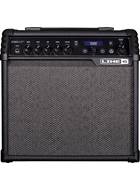Line 6 Spider
1-3 of 3 productsFilter
About Line 6 Spider
Line 6 Spider has long been heralded as one of the best value amps for a new guitarist. Packed with great tones that can be tweaked to your taste, a Line 6 Spider can be a great way to chase your tone thanks to the many famous amp models that you can springboard from and find your direction as a guitarist. Plus with other great features like a built in tuner, stompbox effects and direct to computer recording via USB, is there really anything else you could need from an amp?
The Line 6 Spider is the ever popular range of modelling amplifiers manufactured by Line 6. Extremely popular with beginner players, these amplifiers use computer modelling technology to accurately recreate a wide variety of amp styles, sounds and effects, allowing newer players the ability to experiment and utilise a wide range of presets to find a sound that works for them.
The Line 6 Spider V is the latest in the range, and boasts a range of features and options among the series. From the streamlined and slick 20w, to the stage-ready 240w and everything in between, there's an option for any player and price point.
Why Should I Choose a Line 6 Spider?
- Great modelling technology
- Direct to computer recording
- Easy to use
- Versatile
- Great sounding amp and speaker models
- Range of pricepoints
- Built in FX
- Great for beginners



